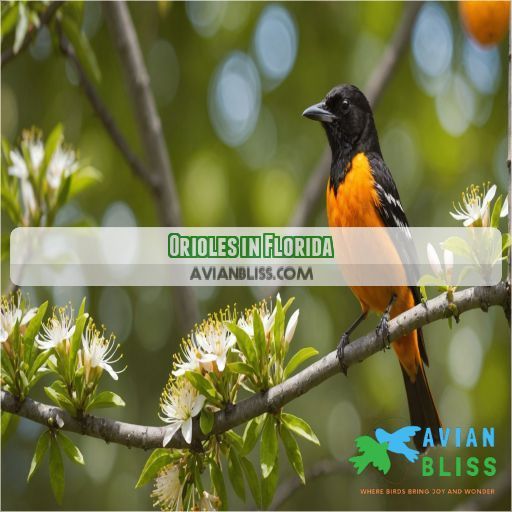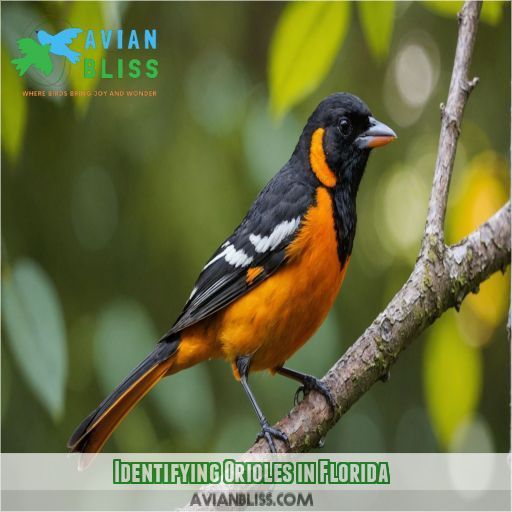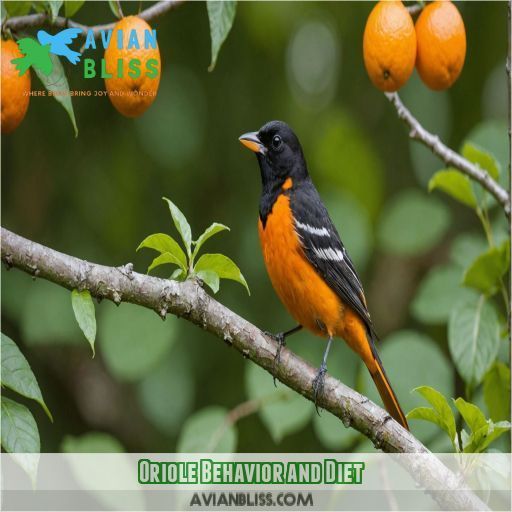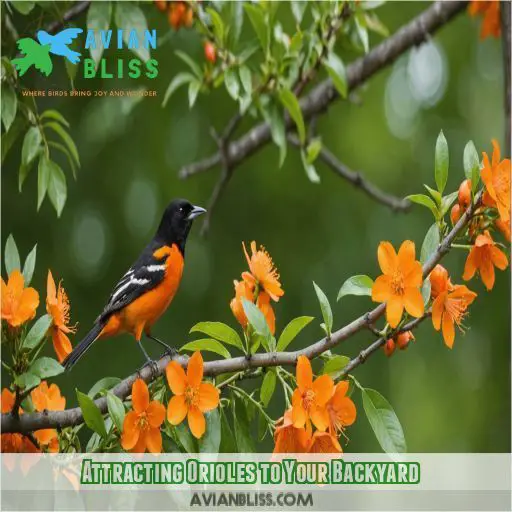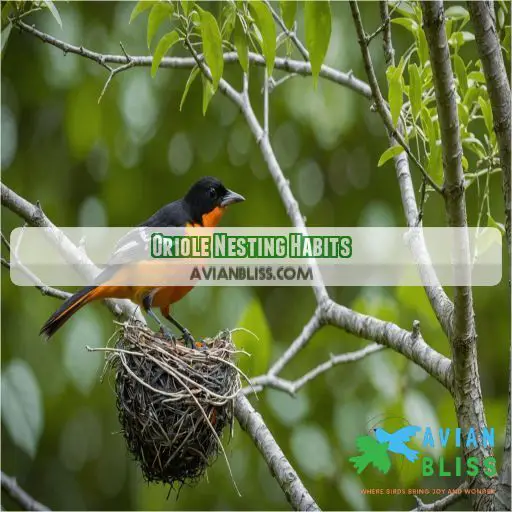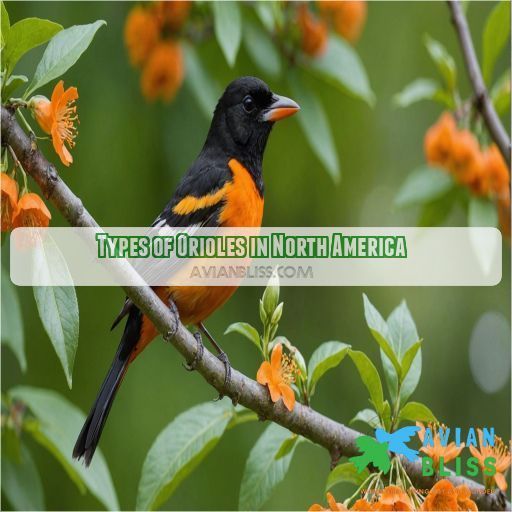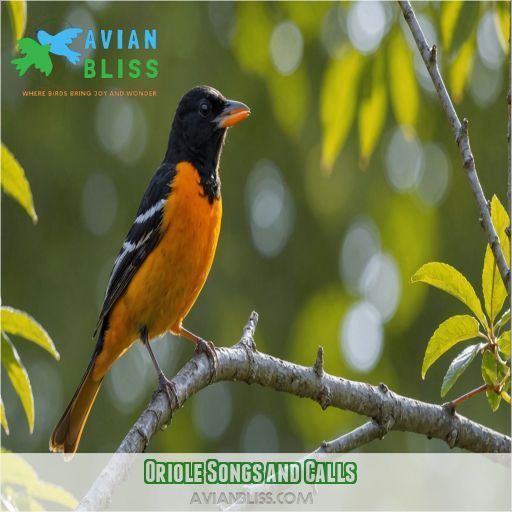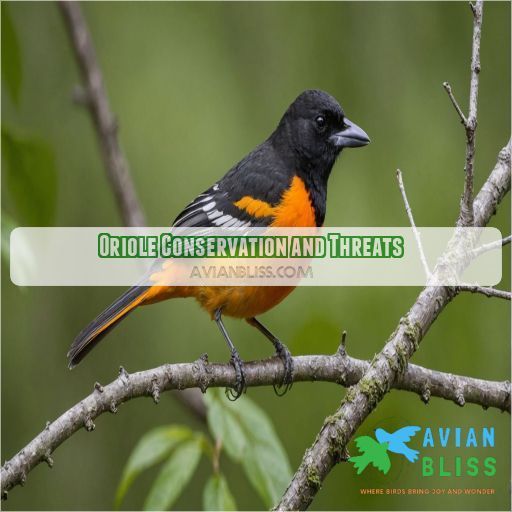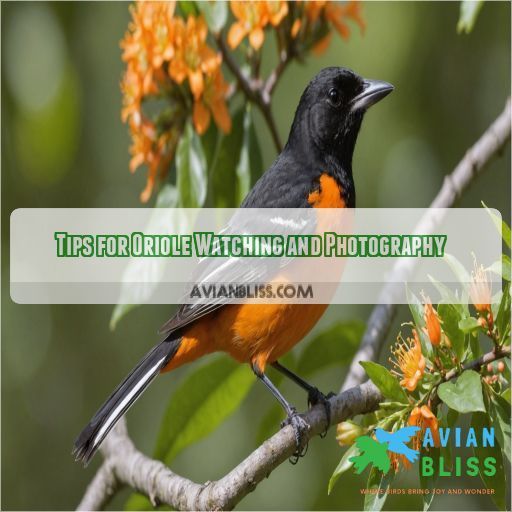This site is supported by our readers. We may earn a commission, at no cost to you, if you purchase through links.
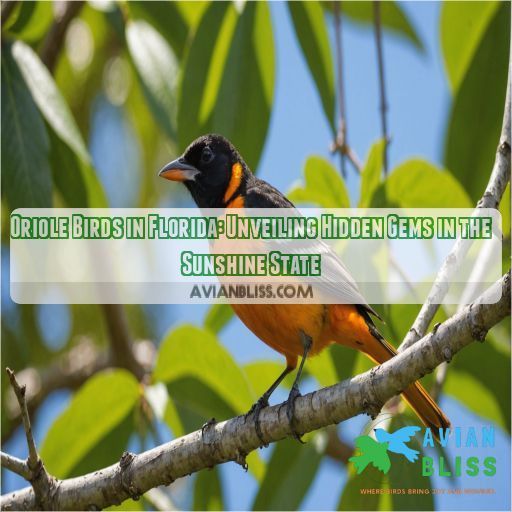
These stunning birds thrive in suburban areas with exotic plants, and their numbers have bounced back from past declines, especially in southern Florida.
But they’re not out of the woods yet – they’re vulnerable to climate change, habitat loss, and disease outbreaks.
Want to learn how to spot these hidden gems, attract them to your backyard, and help protect them? You’re just getting started!
Table Of Contents
- Key Takeaways
- Orioles in Florida
- Identifying Orioles in Florida
- Oriole Behavior and Diet
- Attracting Orioles to Your Backyard
- Oriole Nesting Habits
- Types of Orioles in North America
- Oriole Songs and Calls
- Oriole Conservation and Threats
- Tips for Oriole Watching and Photography
- Frequently Asked Questions (FAQs)
- Are there any orioles in Florida?
- How to attract orioles in Florida?
- What bird looks like an oriole but isn t?
- How can you tell the difference between an oriole and a Baltimore Oriole?
- What is the average lifespan of an oriole in Florida?
- Can orioles in Florida be considered an invasive species?
- How do orioles in Florida protect themselves from predators?
- What is the ideal habitat for orioles in Florida suburbs?
- Can orioles in Florida be kept as pets or domesticated?
- Conclusion
Key Takeaways
- You’re in luck because Florida is home to several oriole species, including the striking Spot-Breasted Oriole, which was introduced from southern Mexico and Central America in the 1940s. These stunning birds thrive in suburban areas with exotic plants, and their numbers have bounced back from past declines, especially in southern Florida.
- As you learn about orioles in Florida, you’ll discover that Climate Change has a profound impact on these birds. Rising temperatures alter their migration patterns, making it harder for them to adapt. Warmer winters also disrupt their food supply, forcing them to find new sources.
- To attract orioles to your backyard, you’ll want to offer their favorite treats, such as orange slices, grape jelly, and nectar-rich flowers. Don’t forget to install an oriole-friendly feeder or two! By incorporating a few simple tips, such as planting oriole-friendly trees and flowers, you’ll be well on your way to creating an oriole haven.
- When spotting orioles in Florida, keep in mind that peak sightings occur during their breeding season, from April to July. Look for them in their favorite habitats, such as suburban areas with exotic plants, and use the best feeders, such as sugar-water feeders, to attract them. The ideal times for spotting these birds are early morning and late afternoon.
Orioles in Florida
Florida is home to several oriole species, including the striking Spot-Breasted Oriole, which was introduced to the area in the 1940s.
You’re in for a treat if you live in or plan to visit Florida – the Sunshine State is home to several oriole species.
As you learn about orioles in Florida, you’ll discover their unique characteristics, habits, and habitats, as well as the challenges they face due to climate change and other environmental factors.
Native Range and Habitat
As you explore Florida’s outdoors, you might stumble upon the vibrant Spot-breasted oriole, a bird native to southwestern Mexico and Central America. Its natural range spans tropical regions, where it thrives in open woodlands and suburban areas with exotic plants, enjoying a warm climate perfect for its survival.
Introduced to Florida in the 1940s
You’re about to meet the Spot-Breasted Oriole, an exotic bird introduced to Florida in the 1940s . Native to Central America, this bird thrives in suburban areas with exotic plants . Its adaptation to Florida’s climate has been successful, but cold winters affect its numbers .
Current Population and Distribution
You’re now part of the oriole fan club! Currently, the Spot-Breasted Oriole population is thriving in southern Florida, particularly between Miami and West Palm Beach. Their numbers have partly recovered from past declines, thanks to suburban areas with exotic plants that provide a haven for these beautiful birds.
Climate Vulnerability and Threats
As you explore the Sunshine State’s oriole population, you’ll notice climate vulnerability and threats are pressing concerns. Rising temperatures, habitat loss, and disease outbreaks all impact these birds. By understanding climate change’s effects and supporting conservation efforts, you can help protect Florida’s orioles .
Identifying Orioles in Florida
As you explore the Sunshine State’s bird scene, you’ll want to know how to spot the stunning orioles that call Florida home. In this section, we’ll break down the key characteristics of the Spot-Breasted Oriole and Baltimore Oriole, so you can confidently identify these beauties on your next birding adventure.
Spot-Breasted Oriole Characteristics
Let’s get familiar with the Spot-Breasted Oriole! This exotic bird boasts a bright orange head, black throat, and distinctive spots on its chest. Juveniles start with a dull yellow plumage, while adults flaunt their vibrant colors. With a penchant for nectar, fruits, and insects, these orioles thrive in suburban areas with exotic plants.
Baltimore Oriole Characteristics
Now that you’re familiar with the Spot-Breasted Oriole, let’s explore the Baltimore Oriole‘s characteristics. As the most common oriole in Florida, males boast a striking orange and black plumage with white wing bars, while females are duller in color. You’ll often spot them in open woodlands, riverbanks, and edges of swamps, fluttering around deciduous trees in search of food.
Differentiating Between Orioles and Other Birds
When spotting orioles in Florida, it’s important to tell them apart from other birds. You might mix up orioles with blackbirds, mockingbirds, tanagers, or warblers. Here are some key differences to look out for:
- Beak shape and size: Orioles have a pointed, medium-sized beak.
- Plumage patterns: Orioles have distinctive orange and black markings.
- Size and shape: Orioles are medium-sized birds with a rounded body.
- Song and call: Orioles have a unique, whistled song that’s often described as musical.
Oriole Behavior and Diet
As you explore the fascinating world of orioles in Florida, you’ll discover that their behavior and diet are really important to their survival and success. By understanding what these birds eat, how they forage, and what they prefer, you’ll be better equipped to attract them to your backyard and appreciate their unique characteristics.
Foraging Habits and Food Sources
When you’re watching orioles in Florida, you’ll notice their unique foraging habits. These birds use their sharp beaks to snatch insects and spiders from leaves and branches. They also visit backyard feeders, competing with other birds for seeds and suet. Seasonal variations in food availability force orioles to adapt, making them fascinating to observe.
Nectar and Fruit Preferences
You’re probably wondering what’s on the menu for these vibrant birds. As it turns out, orioles have a sweet tooth for nectar and a penchant for fresh fruit! They especially love oranges, grapes, and berries. Offering these treats in your backyard can be a great way to attract these stunning birds and satisfy their cravings.
Insect Consumption and Hunting
Orioles rely heavily on insects for their meals. They’re skilled hunters, grabbing bugs out of the air or picking them off leaves. Here are some fascinating facts about orioles’ insect-hunting habits:
- They prey on aphids, caterpillars, and spiders, using their sharp beaks to snatch them up.
- Orioles employ clever hunting strategies, like hovering in front of flowers to catch insects in flight.
- To avoid predators, they’ll often forage in dense foliage or use their agility to dodge danger.
Attracting Orioles to Your Backyard
As you welcome orioles into your Florida backyard, you’ll be thrilled to know that it’s easier than you think to attract these stunning birds. By incorporating a few simple tips, such as planting oriole-friendly trees and flowers, offering oranges and grape jelly, and using sugar-water feeders and nectar feeders, you’ll be well on your way to creating an oriole haven .
Planting Oriole-Friendly Trees and Flowers
Now that you know what orioles love to eat, let’s get planting! Incorporate native plants, fruit-bearing trees, and nectar flowers into your yard to attract these birds. This bird-friendly landscaping will also attract pollinators, creating a thriving ecosystem. Choose plants like elms, cottonwoods, or native palms, and watch your yard become an oriole haven.
Offering Oranges and Grape Jelly
Want to attract orioles to your backyard? Offer them a sweet treat! Orioles love oranges and grape jelly. But, did you know homemade jelly is better for their health? Avoid using store-bought jelly with added sugars. Instead, make your own using fresh grapes. Place it in a safe bird feeder, and enjoy watching these beautiful birds thrive!
Using Sugar-Water Feeders and Nectar Feeders
You’re ready to sweet-talk those orioles into your backyard. Here’s how to use sugar-water feeders and nectar feeders to your advantage:
- Mix it up: Combine 4 parts water with 1 part sugar for a sweet treat.
- Place with care: Position feeders near oriole-friendly plants, like oranges or flowers.
- Keep it clean: Regularly clean and refill feeders to prevent mold.
- Get crafty: Try DIY feeders, like plastic bottles or wooden creations, to add a personal touch.
Oriole Nesting Habits
As you explore the fascinating world of oriole birds in Florida, you’ll discover that their nesting habits are just as interesting as their bright plumage. Let’s take a closer look at where and how these birds build their homes, and what roles both males and females play in raising their young.
Nest Placement and Material Preferences
Orioles have a few favorite spots when it comes to nest placement. They love to build their nests near the end of a slender branch, often well above ground. Let’s break down their nest preferences:
| Nest Location | Nest Material | Nest Size |
|---|---|---|
| End of a branch | Grass, palm fibers | 2-4 inches wide |
| Tree fork | Plant fibers, yarn | 6-8 inches deep |
| Under leaves | Twigs, spider webs | 1-2 cups in volume |
Now, imagine building a cozy little home like this!
Female Oriole Nesting Behavior
You’re now getting a glimpse into the secret lives of female orioles as they build their nests. Here’s what you need to know:
- Nest material: Females collect plant fibers, grasses, and palm fronds to weave a sturdy nest.
- Nest location: They choose a spot with good protection from predators and harsh weather.
- Nest protection: The nest is often hidden behind leaves or in a thorny bush.
- Incubation period: The female oriole sits on her eggs for about 12 days, keeping them safe and warm.
Male Oriole Role in Nesting and Parenting
When you learn about orioles, you’ll see that males play a big part in nesting and raising their young. They protect the nest, feed the babies, and even help choose a mate. Here’s a breakdown of what male orioles do:
| Male Role | Description | Importance |
|---|---|---|
| Nest Defense | Chases away predators | Protects young and territory |
| Feeding Young | Brings food to the nest | Helps the babies survive |
| Territory | Establishes and defends territory | Secures resources and mate |
| Mate Selection | Helps choose a mate | Increases chances of successful breeding |
| Parenting | Assists with childcare | Promotes healthy development |
Types of Orioles in North America
You’re about to meet the fascinating oriole family in North America, with species like the Baltimore Oriole, Orchard Oriole, Bullocks Oriole, and Scotts Oriole. As you explore these oriole types, you’ll discover their unique characteristics, habits, and habitats that set them apart from one another.
Baltimore Oriole (Icterus Galbula)
Now that we’ve explored oriole nesting habits, let’s talk about the Baltimore Oriole. You might be wondering what makes them unique. Here are three cool facts:
- Distinctive songs: Baltimore Orioles have a loud, clear whistle song that sounds like "wheet-wheet-wheet".
- Foodies at heart: They love nectar, fruits, and insects, especially during breeding season.
- Skilled nesters: Females build intricate hanging nests using plant fibers and twigs.
Orchard Oriole (Icterus Spurius)
As you explore Florida’s oriole scene, meet the Orchard Oriole (Icterus Spurius), a migratory bird that breeds in the state’s open woodlands and edges. With its darker orange hue and distinctive song, this bird is a treat to spot during its summer sojourn from May to July.
Bullocks Oriole (Icterus Bullockii)
You’re probably wondering about the Bullocks Oriole, right? Well, let’s get to it!
- Native to the western US, Canada, and Mexico
- Replaces Baltimore Oriole in the west
- Interbreeds with Baltimore Oriole, creating hybrids
- Similar diet and nesting habits to Baltimore Oriole
- Listed as Least Concern on the IUCN Red List
Scotts Oriole (Icterus Parisorum)
You’re on the hunt for the Scotts Oriole (Icterus Parisorum)! Found in the Southwest, these birds favor juniper or oak woods, desert grassland, and areas with yuccas. Males sport yellow and black plumage, while females are plainer yellow. Keep an eye out for their yucca-protected nests.
Oriole Songs and Calls
When you’re out exploring Florida’s birds, you’ll find that oriole songs and calls are a big part of who they are. By learning the different tunes of the Baltimore Oriole, Orchard Oriole, Scotts Oriole, and Spot-Breasted Oriole, you’ll be able to tell them apart and really get a feel for how they act and interact with each other.
Baltimore Oriole Song and Call
As you learn about orioles, listen for the Baltimore oriole‘s song – a loud, clear whistle, often described as "wheet-wheet-wheet." This catchy tune is a key identifier, but be aware that orioles are known to mimic other birds, adding their own twist to the melody.
Orchard Oriole Song and Call
As you explore the world of orioles, you’ll discover the Orchard Oriole’s song is a rapid, jumbled series of notes, often sung from low perches. You might even catch a glimpse of this shy bird as it sings its heart out!
Here are 4 interesting facts about the Orchard Oriole’s song and call:
- Song variations: Orchard Orioles have distinct song patterns, with some individuals singing a more melodic tune than others.
- Call purpose: Their calls serve as a warning signal to alert other orioles of potential predators.
- Song meaning: Researchers believe the Orchard Oriole’s song may be a way for males to establish territory and attract females.
- Song mimicry: Some Orchard Orioles have been known to mimic the songs of other bird species, adding to their musical repertoire.
Scotts Oriole Song and Call
Now, let’s tune in to the Scotts Oriole’s song – a rich, warbling melody that carries far. Compare it to other oriole songs and you’ll notice its unique rhythm. Listen to recordings to improve your bird song identification skills and become an expert in no time!
Spot-Breasted Oriole Song and Call
Get ready to be serenaded! The Spot-Breasted Oriole‘s song is a rich, slow whistle, often described as ‘whee ch-wee-chu-u‘. Listen for this unique melody to identify these birds. Recognizing their song variations will help you better understand their communication and behavior, making you a more confident bird enthusiast.
Oriole Conservation and Threats
As you learn about the vibrant world of orioles in Florida, you’ll also want to think about the challenges these birds face in the wild. From climate change to habitat loss and human impact, understanding the conservation status of orioles will help you appreciate the importance of protecting these beautiful creatures and their habitats.
Climate Change and Its Effects
As you learn about oriole conservation, you’ll discover that climate change has a profound impact on these birds. Rising temperatures alter their migration patterns, making it harder for them to adapt. Warmer winters also disrupt their food supply, forcing them to find new sources. To mitigate this, conservation efforts focus on creating climate-resilient habitats.
Habitat Loss and Fragmentation
As you learn about climate change’s effects on orioles, you must think about habitat loss and fragmentation. Urbanization and deforestation have led to ecosystem disruption, isolating oriole populations. Wildlife corridors can help connect fragmented habitats, but more needs to be done to mitigate these effects. Your awareness can spark positive change for these birds.
Human Impact on Oriole Populations
You play a big role in protecting oriole populations. Human activities like habitat destruction, nest disturbance, and climate change can harm these birds. As urban areas expand, orioles are forced to adapt, leading to conflicts. By being mindful of our impact, we can help preserve their habitats and reduce our footprint on their world.
Tips for Oriole Watching and Photography
When you’re out exploring Florida, get ready to capture the vibrant colors and charming personalities of these beautiful birds. With the right tips and techniques, you’ll be snapping stunning photos and observing these hidden gems up close in no time.
Best Times and Locations for Oriole Spotting
As you venture out to spot orioles, keep in mind that peak sightings occur during their breeding season, from April to July. Look for them in their favorite habitats, like suburban areas with exotic plants. Use the best feeders, such as sugar-water feeders, to attract them. Early morning and late afternoon are ideal times for spotting these birds.
Camera Equipment and Settings for Oriole Photography
When capturing orioles on camera, you’ll want to use a telephoto lens (at least 200mm) to avoid disturbing them. A fast shutter speed (1/1000th of a second) and low ISO (400) will help freeze their movements. Pay attention to composition and lighting – a sunny day with a shallow depth of field will make your photos pop!
Tips for Approaching and Observing Orioles
Now that you’ve got your camera equipment ready, let’s talk about approaching and observing orioles.
Move slowly and calmly, as these birds can be skittish.
Keep a safe distance from their nest locations and be patient – they’ll come to you, especially if you’ve got Bird Feeders with their favorite treats.
Frequently Asked Questions (FAQs)
Are there any orioles in Florida?
You’re in luck! Florida’s home to several oriole species, including the Baltimore Oriole, Orchard Oriole, and the introduced Spot-breasted Oriole . So, grab your binoculars and get ready to spot these stunning birds!
How to attract orioles in Florida?
Want to entice these avian beauties to your yard? To attract orioles in Florida, offer their favorite treats like orange slices, grape jelly, and nectar-rich flowers, and don’t forget to install an oriole-friendly feeder or two!
What bird looks like an oriole but isn t?
You’re wondering what bird looks like an oriole but isn’t? Well, you might be surprised to learn that it’s the juvenile Baltimore Oriole lookalike – the Spot-Breasted Oriole‘s dull yellow youngster or the Orchard Oriole’s 1-year-old male!
How can you tell the difference between an oriole and a Baltimore Oriole?
You’re on a mission to spot an oriole, but which one? To tell a Baltimore Oriole from its cousins, look for its distinctive orange and black plumage, white wing bars, and a dark hood that’s like a stylish hat.
What is the average lifespan of an oriole in Florida?
You’re curious about an oriole’s lifespan. While exact data varies, most orioles in North America live around 2-3 years in the wild, with some species, like the Baltimore Oriole, reportedly living up to 11 years.
Can orioles in Florida be considered an invasive species?
You’re wondering if orioles in Florida are invasive? Well, the Spot-breasted Oriole, introduced in the 1940s, is the only non-native oriole species in Florida , but it’s not typically considered invasive, as it doesn’t outcompete native species .
How do orioles in Florida protect themselves from predators?
When attracting orioles to your backyard, you’re also attracting potential predators. To protect themselves, orioles in Florida use their agility and speed to evade predators, and some species, like the Spot-breasted Oriole, also use their nests as a safe haven .
What is the ideal habitat for orioles in Florida suburbs?
Imagine sipping nectar from a flower-filled paradise! For orioles in suburbs, the ideal habitat is a lush haven with exotic plants, like a backyard with fruit trees, nectar feeders, and sheltering palms – a true avian oasis!
Can orioles in Florida be kept as pets or domesticated?
You’re wondering if orioles can be kept as pets? Unfortunately, it’s not recommended. Orioles are wild birds with complex social and spatial needs that can’t be met in a domestic setting, so it’s best to appreciate them in their natural habitat.
Conclusion
Don’t worry, you don’t need to be a seasoned birder to spot oriole birds in Florida!
With a little patience and knowledge, you can uncover these hidden gems in the Sunshine State.
By learning about their habits, habitats, and vulnerabilities, you’ll be well on your way to attracting and protecting these stunning birds.

